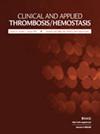利用凝血波形分析检测肝细胞癌患者的血栓前状态
IF 2
4区 医学
Q2 HEMATOLOGY
引用次数: 0
摘要
背景:虽然肝细胞癌(HCC)经常与血栓形成有关,但它也与肝硬化(LC)有关,而肝硬化会导致止血异常。因此,我们使用血块波形分析(CWA)对 HCC 患者的止血异常进行了研究。方法:使用 CWA 激活部分凝血活酶时间(APTT)和少量组织因子诱导 FIX 激活(sTF/FIXa)检测法检查了 88 例 HCC 患者样本、48 例 LC 患者样本和 153 例慢性肝病(CH)患者样本的止血异常情况。结果HCC、LC和CH的CWA-APTT峰值时间无明显差异,HCC和CH的CWA-APTT峰值高度明显高于HVs和LC。HCC 的 CWA-sTF/FIXa 峰高明显高于 LC。B、C和D期的CWA-APTT峰值时间明显长于A期或有反应的病例。在接收者操作特征(ROC)曲线中,CWA-APTT 和 CWA-sTF/FIXa 的纤维蛋白形成高度(FFH)分别显示出对 HCC 和 LC 的最高诊断能力。在13例HCC患者中观察到血栓形成,动脉血栓形成和门静脉血栓形成分别与无LC的HCC和有LC的HCC密切相关。在 ROC 中,CWA-sTF/FIXa 第一次导数的峰值时间×峰值高度对血栓形成的诊断能力最高。结论CWA-APTT和CWA-sTF/FIXa可提高HCC的可评估性,包括与LC和血栓并发症的相关性。本文章由计算机程序翻译,如有差异,请以英文原文为准。
Detection of a Prethrombotic State in Patients with Hepatocellular Carcinoma, Using a Clot Waveform Analysis
Background: Although hepatocellular carcinoma (HCC) is frequently associated with thrombosis, it is also associated with liver cirrhosis (LC) which causes hemostatic abnormalities. Therefore, hemostatic abnormalities in patients with HCC were examined using a clot waveform analysis (CWA). Methods: Hemostatic abnormalities in 88 samples from HCC patients, 48 samples from LC patients and 153 samples from patients with chronic liver diseases (CH) were examined using a CWA-activated partial thromboplastin time (APTT) and small amount of tissue factor induced FIX activation (sTF/FIXa) assay. Results: There were no significant differences in the peak time on CWA-APTT among HCC, LC, and CH, and the peak heights of CWA-APTT were significantly higher in HCC and CH than in HVs and LC. The peak heights of the CWA-sTF/FIXa were significantly higher in HCC than in LC. The peak times of the CWA-APTT were significantly longer in stages B, C, and D than in stage A or cases of response. In the receiver operating characteristic (ROC) curve, the fibrin formation height (FFH) of the CWA-APTT and CWA-sTF/FIXa showed the highest diagnostic ability for HCC and LC, respectively. Thrombosis was observed in 13 HCC patients, and arterial thrombosis and portal vein thrombosis were frequently associated with HCC without LC and HCC with LC, respectively. In ROC, the peak time×peak height of the first derivative on the CWA-sTF/FIXa showed the highest diagnostic ability for thrombosis. Conclusion: The CWA-APTT and CWA-sTF/FIXa can increase the evaluability of HCC including the association with LC and thrombotic complications.
求助全文
通过发布文献求助,成功后即可免费获取论文全文。
去求助
来源期刊
CiteScore
4.40
自引率
3.40%
发文量
150
审稿时长
2 months
期刊介绍:
CATH is a peer-reviewed bi-monthly journal that addresses the practical clinical and laboratory issues involved in managing bleeding and clotting disorders, especially those related to thrombosis, hemostasis, and vascular disorders. CATH covers clinical trials, studies on etiology, pathophysiology, diagnosis and treatment of thrombohemorrhagic disorders.

 求助内容:
求助内容: 应助结果提醒方式:
应助结果提醒方式:


